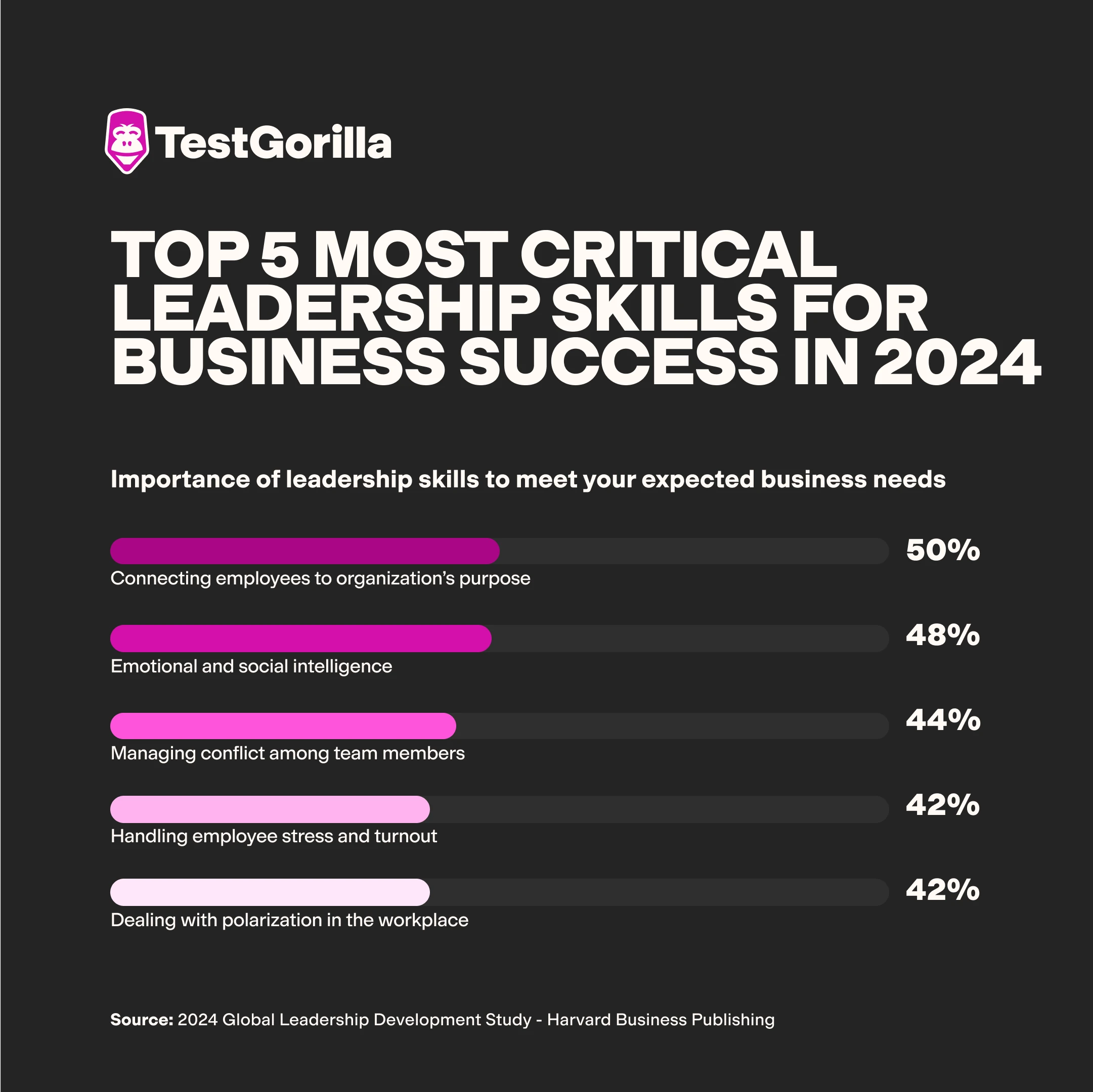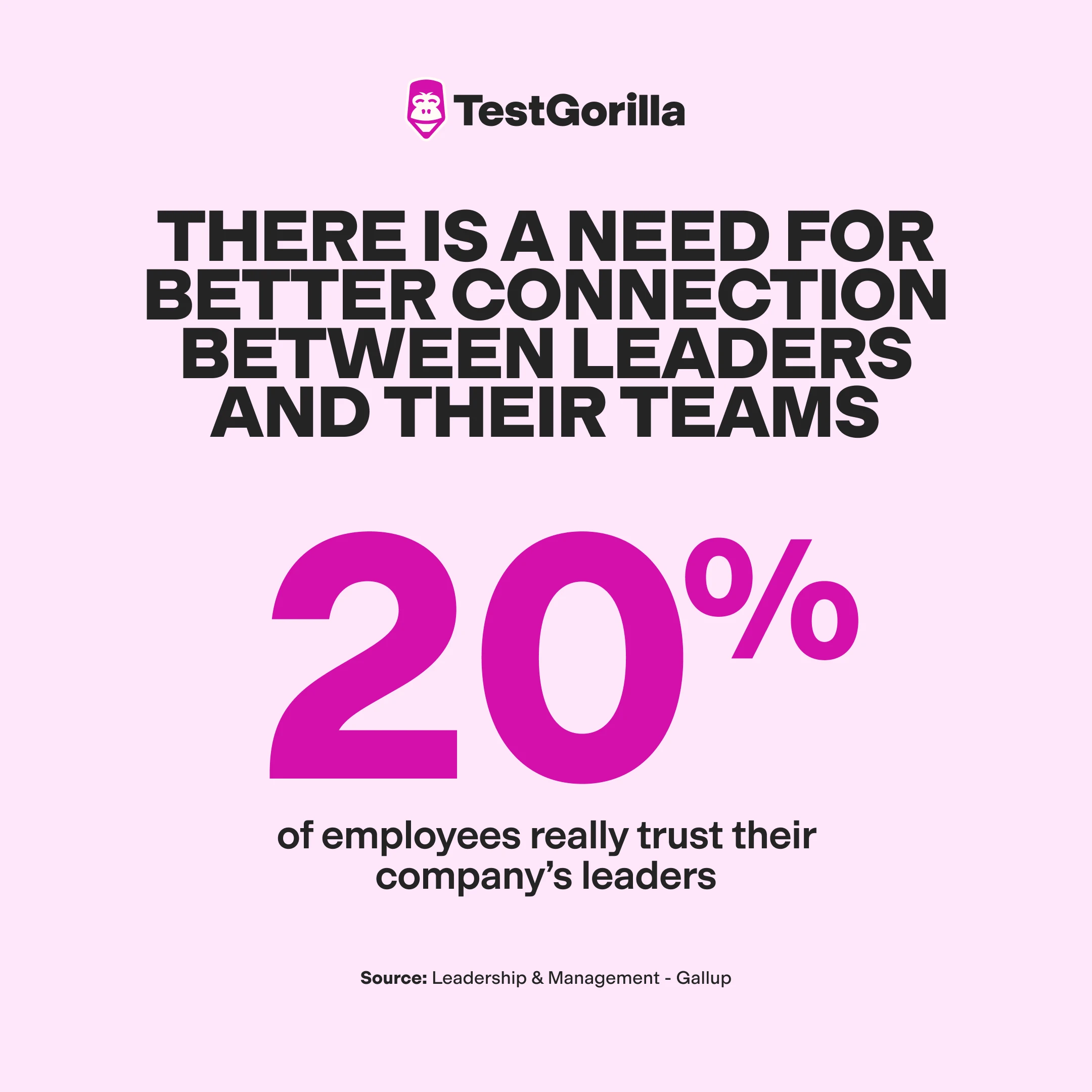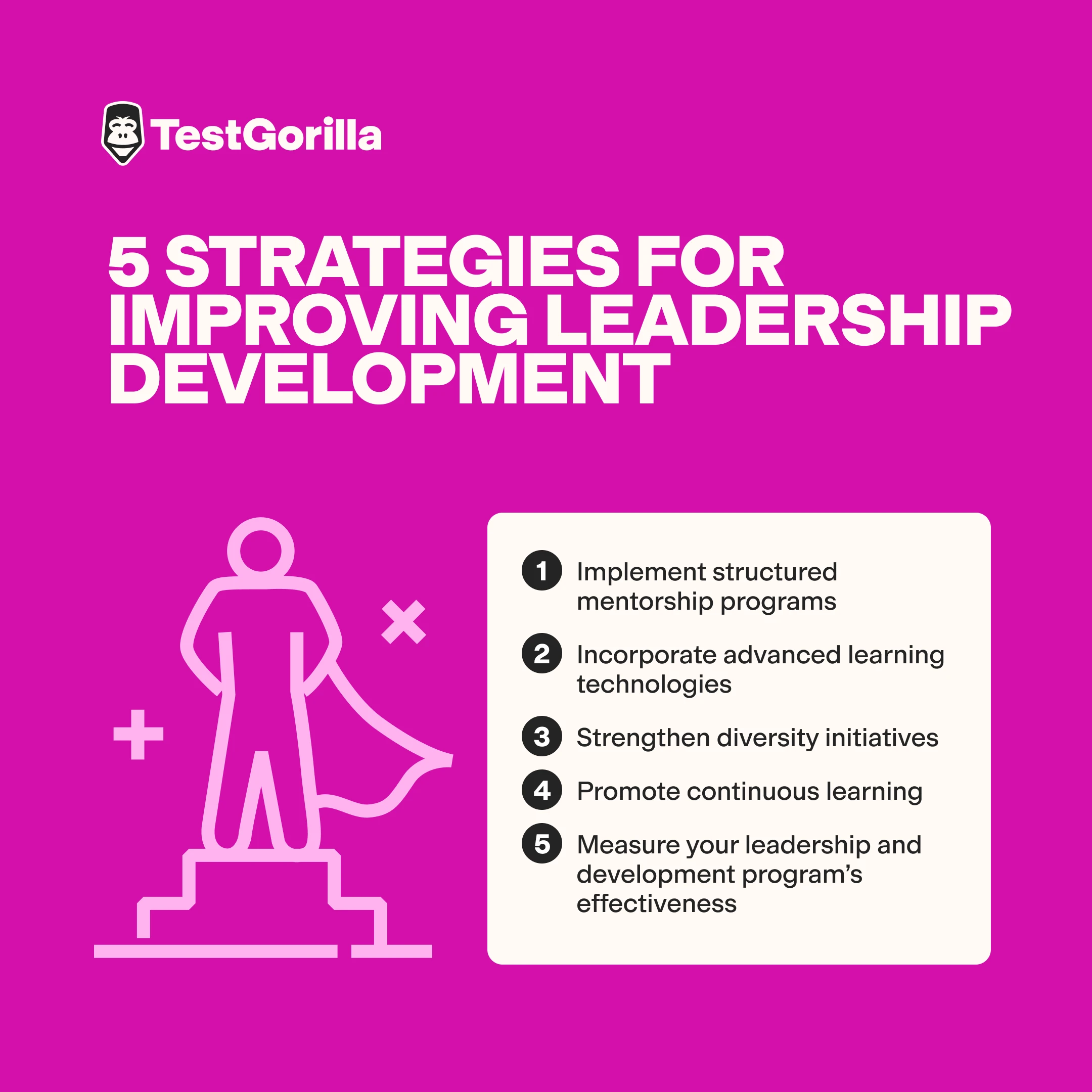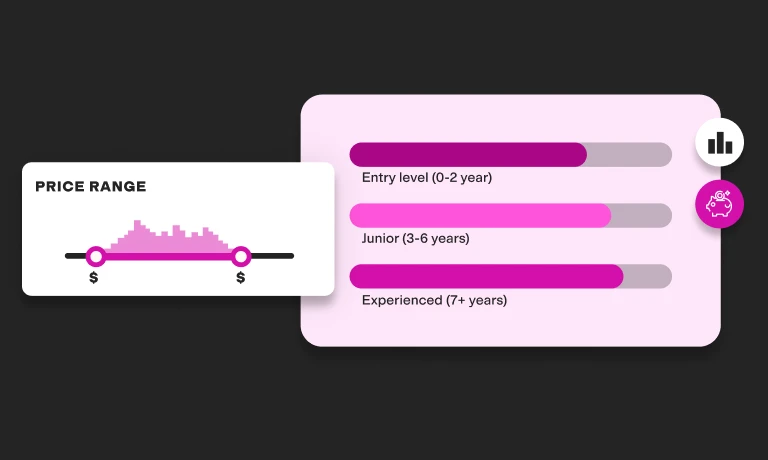Leadership development statistics: Everything you need to know
Leadership can make or break your organization, so leadership development is vital. Statistics give us insights into the current state of leadership in the business landscape – including the impacts of bad leaders, the growing importance of leadership development programs, and opportunities for improving leadership and development training.
Knowing these stats and more can help you reflect on the state of leadership development in your own organization – so you can pinpoint what you’re doing well and what needs work.
Below, we share some meaningful leadership development stats. Plus, we share some handy tips you can use to improve leadership development in your company.
How we researched this topic
To compile the latest data on leadership development, we consulted various trusted organizations and reputable sources, including LEADx’s Leadership Development Benchmark Report 2024 and Harvard Business Publishing’s 2024 Global Leadership Development Study, plus some studies from Gallup, McKinsey, and more.
These sources surveyed large samples of employers, employees, and more firsthand to gather the statistics referenced in this article.
Key takeaways
Leadership development statistics reveal how much organizations prioritize leadership development (and which aspects of it they prioritize the most) and highlight the benefits of investing in its improvement
Just over half of organizations make leadership development a priority.
Bad leadership can cost organizations nearly a tenth of their annual sales.
Most employees, especially Gen Z and Millennials, want more development from their employers – including help moving up the career ladder – and many are willing to leave if it’s not offered
12 important leadership development statistics
Let’s dive into some key leadership development stats for 2024 and see what they reveal about building stronger teams and keeping your best talent.
1. Just over half of companies prioritize leadership development
Leadership development is evolving, especially since the pandemic shook things up and we’ve moved more into hybrid work models.
Now, 54% of companies insist on leadership training – that’s up 10% from last year. While that's a good jump, it shows that making sure leaders are up to snuff still isn't a top priority for nearly half the businesses out there.
2. Reducing turnover and increasing employee engagement are 2 top priorities of leadership and development
The largest proportion of respondents (51%) for the 2024 Global Leadership Development Study said their leadership development training will focus on reducing employee turnover.
Meanwhile, the majority of respondents (37%) for the Leadership Development Benchmark Report 2024 said that employee engagement and satisfaction would be the metric they’d use to measure their success.
Both priorities are related to employee retention, highlighting the importance of leadership development to retention efforts.
3. 63% of leadership development professionals prioritize productivity
When it comes to leadership and development initiatives concerning remote and hybrid work, increasing productivity for people who work from home or have a mix of home and office work days is the main focus right now. About 63% of companies are making this a priority – no matter where they are in the world.
People who handle learning and development in companies are zeroing in on this, even more so than other leaders. And in industries like professional services, IT, and media, at least 70% of companies are actively trying to make their remote and hybrid workers more productive.
4. Leadership development improves employee engagement and growth by 60%
In a study involving over 13,000 participants who received leadership development, there was a boost in how these leaders engaged their teams and helped others grow. In fact, just two months after their training, participants reported seeing an average improvement of 60% in these engagement skills.
And it turns out, there's a big payoff to getting employee engagement right. According to Gallup, companies that excel in engaging their workforce aren't just better places to work. They're also 21% more profitable and outperform others with a 17% higher productivity rate.
5. 7 in 10 L&D stakeholders believe leaders must master various leadership behaviors to meet future business needs
The leadership skills that leadership and development and HR professionals see as being most important have changed from 2023 to 2024. For example, skills like connecting employees to an organization’s purpose, emotional and social intelligence, and managing conflict are increasingly valued.
*From Harvard Business Publishing’s 2024 Global Leadership Development Study
That’s not all: Almost 70% of leadership and development stakeholders (i.e., buyers and functional heads) believe that leaders must command various leadership skills to succeed in meeting future business needs.
This points to the growing importance of skills development and skills-based hiring.
6. Stakeholders can do more to measure the success of their leadership and development programs
Only 39% of leadership and development professionals measure whether participants of leadership and development training apply what they learn through the programs – and only 22% measure the benefits. Meanwhile, 86% measure how learners react to the training.
Organizations wanting to measure the impact of their future leadership and development programs must do more than just look at program participants’ reactions to the training: They’ll need to see how the training impacts participants’ leadership capabilities and – as a result – their organizations’ success.
7. Employee trust in leadership is at 20%
Only 20% of employees really trust their company’s leaders. That’s a wake-up call. It tells us there’s a big gap in how leaders are connecting with their teams, especially when everyone isn’t in the same room anymore. It also highlights the need for leadership development programs to prioritize soft skills like emotional intelligence and transparency that leaders can use to foster trust with their team members.
Without trust, employees may be less likely to follow through on decisions or embrace changes, making the organization less agile and slower to respond to market demands. Plus, without trust, people aren't going to speak up with their own ideas or concerns, which means fewer chances for the company to get better.
8. More than a third of employees quit over company leadership
According to a recent report, 34% of surveyed participants pointed to problems with their bosses or company leadership as the reason for their departures from their companies. This is a sharp rise from the 19% reported in 2016.
Clearly, there's a growing need for better leadership. Strengthening leadership development programs can help – not just by improving management skills but also by building better relationships between leaders and their teams, potentially decreasing turnover.
9. Poor leadership can drain nearly one-tenth of annual sales
Leadership that isn't up to par hits the bottom line. For example, less-than-stellar leadership practices can drain as much as 7% of a company's total annual sales. Plus, most organizations face a 5-10% drop in productivity due to ineffective leadership. Improving leadership skills across the board could not only recover this lost productivity but also boost overall organizational performance.
10. Nearly 3 quarters of Gen Z and millennials are considering quitting over lack of skill development
A survey of Millennial leaders revealed that 36% of them felt unprepared when entering their leadership role – pointing to a lack of adequate leadership development.
Meanwhile, for Gen Z and other Millennials, feeling stuck in their careers is a big deal-breaker. In fact, 74% of them say that not having enough chances to move up or develop new skills is a major reason they're thinking about leaving their jobs.
11. Less than a quarter of women have had a formal mentor
It turns out that women leaders often miss out on formal mentoring, especially compared with their male colleagues. Only about 24% of women leaders have had formal mentors, while 30% of men have.
And as you climb the ladder, this gap only widens: at senior levels, only 27% of women have had mentors – versus 38% of men.
This shortage points to a big opportunity in leadership development programs to bridge this gap and ensure women have the same access to mentorship, which is crucial for advancing their careers.
12. 8 in 10 workers say learning gives them a sense of purpose professionally
Eighty percent of workers say that learning new skills gives their work more purpose. That’s a key insight for companies: When people find purpose in their work, they tend to be more productive and engaged.
The gist? Focusing on leadership development could align companies’ training programs with what employees care about personally and professionally.
5 strategies for improving leadership development
Here are some specific and actionable ways you can tweak your leadership development for success.
1. Implement structured mentorship programs
According to a survey conducted by the Association for Talent Development (formerly the American Society for Training and Development), 75% of executives believe mentorship was critical to their career development.
So, set up a formal mentorship system where experienced leaders are paired with newer employees. Provide training for mentors on how to guide effectively and measure the progress of both mentors and mentees through regular feedback sessions – perhaps using mentorship software.
It should be more than just casual advice or guidance. It must be a structured relationship where mentors provide comprehensive support and insights, focusing on substantive development rather than just occasional tips.
2. Incorporate advanced learning technologies
Invest in virtual reality (VR) setups or gamified learning platforms. Start with VR pilot projects that simulate critical leadership scenarios, as VR training significantly boosts retention – schools report a 75% retention rate with VR, far surpassing lectures at 5%, reading at 10%, and audio-visual methods at 20%
For gamification, integrate these techniques into existing training modules to make learning more interactive and enjoyable.
3. Strengthen diversity initiatives
According to McKinsey's research on leadership and diversity, businesses that rank in the top quartile for ethnic and gender diversity among executive teams are 39% more likely to outperform those in the bottom quartile. It’s a clear sign that diversity in leadership isn’t just the right thing to do – it’s also smart for business.
Partner with universities, community organizations, or professional networks to find candidates from underrepresented groups. Consider setting up leadership development scholarships or sponsorship programs to support their growth. Internally, run workshops to help current leaders understand the value of diversity and how to lead inclusively.
You can also create employee resource groups (ERGs) or mentorship programs that connect diverse employees with leadership opportunities, ensuring they feel supported as they grow into leadership roles.
4. Promote continuous learning
Develop a continuous learning culture by providing access to ongoing online courses, workshops, and seminars that address current industry trends and leadership challenges.
Encourage leaders to set personal development goals each quarter and offer incentives for meeting these goals. Giving employees more control over their leadership development helps them focus on the skills they need to grow while contributing to the company’s success.
5. Measure your leadership and development program’s effectiveness
Look at key metrics when measuring the impact of your leadership and development programs. See if and how your leaders apply what they learn – and whether this positively impacts your business’s outcomes.
For example, track the retention rates of their direct reports, and track engagement rates by observing changes in employee satisfaction surveys before and after program implementation. Also, assess the skills of your leaders – such as emotional intelligence and conflict management – using skills-based assessments and feedback mechanisms.
Look for opportunities for improvement and make changes as necessary.
The best insights on HR and recruitment, delivered to your inbox.
Biweekly updates. No spam. Unsubscribe any time.
Level up your hiring process with talent assessments
Leadership development plays a big role in your team’s growth and your company’s future success. Knowing stats on the current state of leadership and development training can help you begin to determine the best ways to invest in your leadership and development programs.
Planning to hire new leaders? You can use skills-based hiring to identify candidates with great leadership potential and essential skills. TestGorilla offers 350+ tests science-backed assessments to identify leadership skills.
Start your free trial today and see how TestGorilla can help you build stronger leaders.
FAQs
How can small businesses implement leadership development with limited budgets?
Small businesses can use free or affordable tools like Coursera to offer leadership training without breaking the bank. You can also encourage on-the-job learning by giving employees stretch assignments or opportunities to take on new responsibilities. In addition, cost-effective strategies – like casual lunch-and-learn sessions where team members or local experts share insights – are also useful.
How can organizations identify employees with leadership potential?
Use tools like skills-based assessments, performance reviews, and 360-degree feedback to pinpoint employees with leadership potential. Look for traits like adaptability, problem-solving, and strong interpersonal skills. Check out our guide, how to assess leadership skills, for more info.
Related posts
You've scrolled this far
Why not try TestGorilla for free, and see what happens when you put skills first.





















